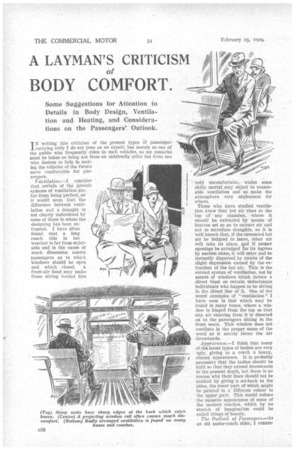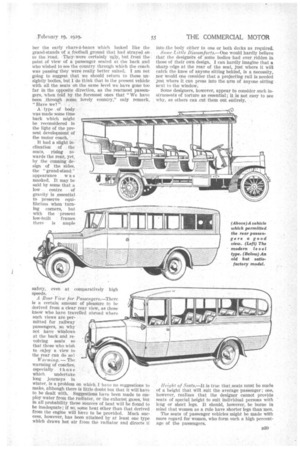A LAYMAN'S CRITICISM of
Page 144

Page 145

If you've noticed an error in this article please click here to report it so we can fix it.
BODY COMFORT.
Some Suggestions for Attention to Details in Body Design, Ventilation and Heating, and Considerations on the Passengers' Outlook.
TN writing this criticism of the present types (If passenger'carrying body I do not pose as an expert, but merely as one of the public who frequently -rides in such vehicles, so my remarks must be taken as being not from an unfriendly critic but from one who desires to help in making the vehicles of the future more comfortable for passengers.
• Vey/tart fion.—I consider that certain of the present syStems of ventilatiOnare far he being perfect, as it would seem that the difference between ventilation and a draught is not clearly understood by some of those to whom the
designing has been entrusted. I have often found that a long coach ride in hot weather is far from enjoyable and Is the cause of much dissension among passengers as to which windows should be open and which closed. A .fresh-air fiend may make those sitting behind him very uncomfortable, whilst some chilly mortal may object to reasonable ventilation and so make the atmosphere very unpleasant for others.
Those who have studied ventilation know that hot air rises to the top of any chamber, where it should be extracted by means of louvres set so as to extract air and not to introduce draughts, as it is well known that, if the unwanted hot air be induced to leave, other air will take its place, wad if proper openings be arranged for its ingress by suction alone, it will enter and be instantly dispersed by means of the slight depression caused by the extraction of the hot air. This is the correct system of ventilation, not by means of windows which induce a direct blast on certain unfortunate Individuals who happen to be sitting in the direct line of it. One of the worst examples of "ventilation" I have seen 'is that which may be found in many buses, where a window is hinged from the top so that any air entering from it is directed on to the passengers sitting in the front seats. This window does not ventilate in the proper sense of the word as it merely blows the air downwards.
..4ppearance.—I think that many of the latest types of bodies are very ugly, giving to a coach a heavy, clumsy appearance. It is probably necessary that the bodies should be built so that they extend downwards to the present depth, but there is no reason why their lines should not be studied by giving a set-back to the sides, the lower part of which might be painted in a different colour to the upper .part. This would relieve the massive appearance of some of the modern coaches, which by no stretch of imagination could be called things of beauty.
The Outlook of Passevgers.—As an old motor-coach rider, I remem ber the early chars-a-banes which looked like the grand-stands of a fOotball ground that had strayed on to the road. They-were certainly ugly, but .from the: point of View of a passenger seated at the back and who wished to see the country through which the coach was passing they were really better suited. I am not going to suggest. that we should return to these, unsightly bodies, but I do think that in the present vehicle. with all the seats on the same level we have gone too far in the opposite direction, as the rearmost passengers, when told by the foremost ones that "We have been .through some lovely country," only remark, "Have we? ".
A type , of bodywas made some time back which might be recOnsidered in the light Of the present development of the motor coach.
It had a slight in clination of the seats, rising towards ihe rear, yet, by the cunning sign of the 'sides, the " gTand-stand " appearance was masked. It may be said by some that a low centre of gravity is _essential to preserve equi librium when turn ing corners, but with the present low-built frames
there is nmple
safety, even at comparatively high speeds.
A Rear View for Passengers.—There is a certain amount of pleasure to be derived from a clear rear view, as those know who have travelled abroad where such views are permitted for railway passengers, so why not have windows at the back and revolving seats so that those who wish to enjoy a view to the rear can do so?
Warming. — The warming of coaches, especially those which undertake long journeys in winter, is a problem on which. Iha ve no suggestions to make, although there is little doubt but that it will have to be dealt with. Suggestions have been made to employ water from the radiator, or the exhaust gases, but in all probability these sources of heat will be found to be inadequate ; if so, some heat other than that derived from the engine will have to be provided. Much success, however, has been attained by at least one type which draws hot air from the radiator and directs it
into_the body either to one or both decks as required.
Some Little Discomforts.—One would hardly believe that the designers of some bodies had ever ,ridden in those of their own design. I can hardly imagine that a sharp edge at the rear of the seat, just where it will catch the knee of anyone sitting behind, is a necessity, nor would one consider that a projecting rail is needed just where it can press into the arm of anyone sitting next to the window. ,
Some designers, however, appear to consider such instruments of torture as essential; it is not easy to see why, as others can cut them out entirely.
Ileight of Seats.—It is true that seats must be made of a height that will suit the average passenger ; one, however, realizes that the designer cannot provide seats of special height to suit individual persons with long or short legs. It should, however, be borne in mind that women as a rule have shorter legs than -men,
The seats of passenger vehicles might be made with more regard for women, who form such a high percentage of the passengers.




























































































































































































































